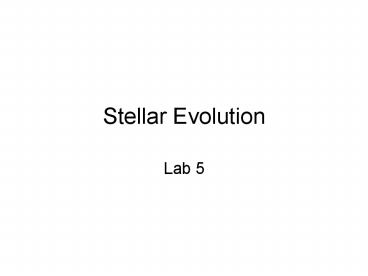Stellar Evolution - PowerPoint PPT Presentation
1 / 18
Title:
Stellar Evolution
Description:
Sirius B = 0.01 solar radius. Sun = 1 solar radius. Spica = 10 solar radii ... V Main sequence Sun, Sirius. not classified White dwarfs Sirius B, Procyon B ... – PowerPoint PPT presentation
Number of Views:97
Avg rating:3.0/5.0
Title: Stellar Evolution
1
Stellar Evolution
- Lab 5
2
What is a Star?
- The basic difference between a star and a planet
is that - a star emits light produced in its interior by
nuclear 'burning - a planet only shines by reflected light
3
The Hertsprung-Russell Diagram
- In 1912, Danish astronomer Ejnar Hertzsprung and
American astronomer Henry Russell independently
graphed the luminosity vs. temperatures for
thousands of stars and found a surprising
relationship - The Hertzsprung-Russel (H-R) diagram shows the
evolution of stars based on their characteristics
of surface temperature, luminosity and mass
4
H-R Diagram and Main Sequence Stars
- The H-R Diagram shows that most of the stars lie
along a smooth diagonal curve called the main
sequence where - Hot, luminous stars appear on the upper left
- Cool, dim stars in the lower right
- 90 of the stars fall on the main sequence
5
(No Transcript)
6
Off Main Sequence Stars
- Off the main sequence, there are
- cool, bright stars in the upper right
- hot, dim stars in the lower left
7
Main Sequence Stars
- A large number of stars are
- chemically homogeneous
- burn hydrogen to helium in their cores
- emit luminosity inversely proportional to the
4th power of their Temp - emit luminosity directly proportional to the
4th power of their mass - These stars are called main-sequence stars
8
Luminosity vs radius
- the radius of the stars increases as proceed
bottom left diagonally to top right - Sirius B 0.01 solar radius
- Sun 1 solar radius
- Spica 10 solar radii
- Rigel 100 solar radii
- Betelgeuse 1000 solar radii
9
Mass vs luminosity
- stars along the main sequence vary from the
highest (30 solar masses) at the top left to the
lowest ( 0.1 solar mass) at the bottom right - our Sun is an average star
10
Classes of Stars by Luminosity
- The H-R diagram summarizes the types of stars in
the universe - Class Description Familiar Examples
- Ia Bright Supergiants Rigel, Betelgeuse
- Ib Supergiants Polaris (the North star),
Antares - II Bright Giants Mintaka (delta Orionis)
- III Giants Arcturus, Capella
- IV Sub-giants Altair, Achenrar
- V Main sequence Sun, Sirius
- not classified White dwarfs Sirius B, Procyon B
- White dwarfs stars are not classified because
their stellar spectra are different from most
other stars
11
Life on the Main Sequence
- Stars on the main sequence burn by fusing H into
He - Large stars tend to have higher core temperatures
than smaller stars, so they burn the hydrogen
fuel in the core quickly and have shorter
lifetimes
12
HYDROGEN!!!!!!
- Small stars burn H more slowly.
- The length of time a star spends on the main
sequence depends upon how quickly the hydrogen
gets used up - Once the hydrogen in the core is gone the mass of
the star determines what happens next - The Sun is halfway through its life of 10
billion years
13
Limits Shown on H-R
- H-R shows a definite upper limit for Main
Sequence stars, all stars more massive than this
will have ended their hydrogen burning existence
already. - Maximum mass for a Main Sequence is 60 times
the Solar Mass - Minimum mass of a star is 0.1 of a Solar Mass,
the mass required to produce nuclear reactions in
the core. - The surface temperature of stars varies from 2000
to 35,000 degrees - Smaller stars are much more numerous than other
types of stars.
14
(No Transcript)
15
Explanation
16
Another Version of the H-R
17
Yet Another Version
18
Interrelationships































